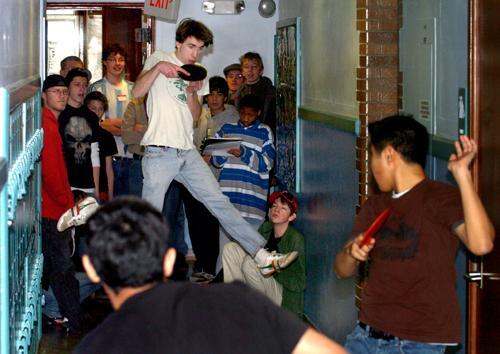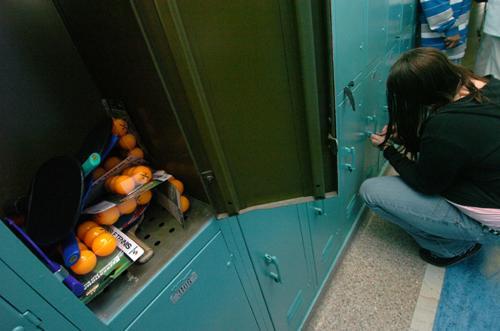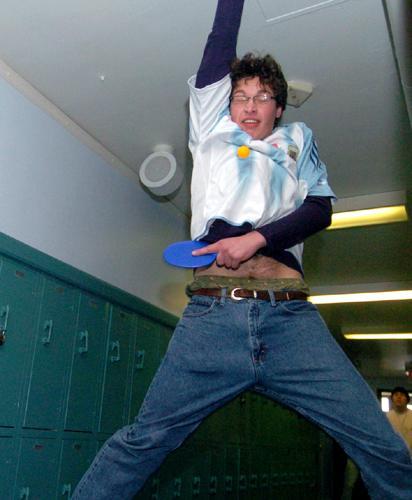Open School's Fraquetball featured in Pioneer Press

-
From the Jan. 13, 2007 Pioneer Press
Fraquetball's fierce fellowship
A game invented at St. Paul's Open School has spurred rivalries, trash-talking and its own hall of fame.
BY DOUG BELDEN
Pioneer Press
It has a commissioner, a hall of fame, historic rivalries, pages of stats on the Web, a rulebook with official-sounding language and lots of trash-talking.
And you've never heard of it.
It's Fraquetball, conceived as a cross between foosball and racquetball but more akin to a game you and your friends might make up in the basement if you were bored and it was too cold to go outside.
That's pretty much how it got started, back in 2003 at St. Paul's Open School.
A gym teacher had some pingpong paddles and balls lying around, and "we just started playing around with them," said Liam Shramko, an eighth-grader at the time and now a senior at the K-12 school in the West Seventh neighborhood.
It began in the main hallway of the third floor, but given that it tends to involve large people swinging paddles and sending balls rocketing every which way, it was quickly moved to a narrow side hall with a little-used elevator at one end.
Fraquetball is played only at Open School, as far as anyone knows. Games are held at lunch, and the rules are simple.
Two teams of two players face each other on either side of a line inthe middle of the hallway. There are goal lines taped to the floor ateach end of the hallway. The object is to hit the ball over your opponent's goal line. First team to seven points wins (but it must win by two).
Because the ability to stop a fast-moving ball with various parts of your body is highly valued, "it really helps being big," said Tim Leone-Getten, who teaches English language learners at the school and has been a competitive Fraquetballer since the beginning.
Doug Anderson is big.
The 2006 Open School grad, who holds the all-time records for goals, aces, steals and blocks and is known as "the Barry Bonds of Fraquetball," was back Wednesday to lead his team, Grease Lightning, to victory over a team called Six-One-Tizzou.
"One of the techniques I pioneered was the pick," Anderson explained after the game, referring to a move in which his teammate runs up to the mid-line to distract the opponent while Anderson slams the ball toward the goal.
If Anderson is the Bonds of Fraquetball and Shramko is seen as its Abner Doubleday, then Nathan Jesson is the sport's Kenesaw Mountain Landis.
Fraquetball's first commissioner and the one who, in his words,"brought Fraquetball out of the Stone Age," Jesson organized the first tournament in February 2003 and developed many of the statistics, scheduling formats and awards that make up the modern-day game.
He also spent hundreds of dollars on pingpong supplies, often buying in bulk. "I'd get the strangest stares from the clerks. One guy asked meif I was making a bomb," he said.
But Jesson is now a freshman in college, and Fraquetball keeps evolving.
This year, for instance, it became illegal for players to use their non-paddle hand to set up a shot.
"It was ruining the integrity of the game," said Shramko, the current commissioner. "We want to keep the competition up."
In a school that doesn't use letter grades, students jump at the chance to compete, Leone-Getten said. And because Open School has no varsity sports (students can join teams at Central High), "this kind of thing becomes a bigger deal," he said. "Their creative juices get put into this sport."
As the name implies, Open School is a product of the progressive "open classroom" movement of the late 1960s and early 1970s. It is the district's only K-12 school, and enrollment is a little more than 400 students. Relationships between faculty and students are prized, and first names are used for everyone, even the principal.
"The object is to encourage kids to be internally motivated," said principal Todd Bartholomay. Students feel "empowered to help shape the school."
Shramko said he's confident his contribution to shaping the school will carry on after he graduates this spring.
And both he and Anderson are headed to Evergreen State College in Washington state this fall, so it's possible Fraquetball will one day be transplanted beyond the third-floor hallway of Open School.
But for now, there's a season to get through.
Thirty-two students in grades seven through 12 and eight staff members are competing this year in a 13-game schedule that started in mid-December and will end sometime in March.
The second featured match Wednesday was Shramko and his Fetal Attraction teammate, Andrew Hoaglund, against Jaime Avila and Jose Garcia of Chivas.
"It's been very intense," Avila, a junior, said of the rivalry between him and Shramko. "We don't like to lose to each other."
"Reigning MVP for a reason!" Avila shouted at Shramko after Chivas beat Fetal Attraction 7-3. Trash-talking is nothing new between those two. Shramko said in the student newspaper last spring that Avila was not the Michael Jordan of Fraquetball but rather "a poor man's Latrell Sprewell."
Wednesday's loss stung Shramko, but many Fraquetball insiders expect Fetal Attraction will get another shot at Chivas in this year's finals.
Still, "a loss is a loss," Shramko said. "That's going to hurt us when we get seeded in the playoffs."
Fraquetball 101
The game was developed by students at St. Paul's Open School and is played there exclusively, as far as anyone knows. Games are held at lunchtime in a hallway on the third floor. There are four players, two on each team. The equipment consists of four pingpong paddles and a pingpong ball.
The teams must stay on their side of a line taped across the middle ofthe hallway. There are goal lines taped on the floor at either end of the hall. Play starts when a team serves from behind its goal line. Both teams try to hit the ball past their opponents' goal line and prevent their opponent from hitting it past their own, usually by blocking it with their body or paddle.
A point is scored when the ball crosses the goal line. The first team to score seven points wins, but it must win by two points. Games usually last about 10 minutes.
To Learn More
For Fraquetball rules, statistics, a diagram of the court and other information, visit fraquet.tripod.com.








